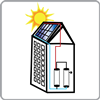|
|
I will drive this vehicle miles per year.
I can sell my current vehicle for $ and purchase a new one for $- Price of gasoline: $ per gallon

- Well-to-pump emissions: 20% of fossil fuel emissions. This includes emissions from the fuel used to find, extract, transport and refine crude oil into gasoline
- Greenhouse gas emissions from vehicles manufacturing: 53 grams CO2e per mile (8 metric tons per vehicle / 150,000 miles lifespan)
- Not included: emissions from road construction and maintenance, and other government-related emissions
|
|
 I will trade in
which gets 0
miles per gallon and buy a more efficient alternative fuel vehicle that gets
miles per gallon.
I will trade in
which gets 0
miles per gallon and buy a more efficient alternative fuel vehicle that gets
miles per gallon. I will drive this vehicle miles per year. Alternative fuel will cost $/gal.
I can sell my current vehicle for $ and purchase a new one for $- Price of gasoline: $ 0 per gallon

- Well-to-pump emissions: 20% of fossil fuel emissions. This includes emissions from the fuel used to find, extract, transport and refine crude oil into gasoline
- Greenhouse gas emissions from vehicles manufacturing: 53 grams CO2e per mile (8 metric tons per vehicle / 150,000 miles lifespan)
- Alternative fuel: CNG
- A number of rebates are available for alternative fuel vehicles from state, federal and local agencies. We assume $2,000 rebate per vehicle is available at the time of purchase
- Not included: emissions from road construction and maintenance, and other government-related emissions
|
|
 I will trade in
which gets 0
miles per gallon and buy a more efficient electric vehicle that gets
miles per gallon.
I will trade in
which gets 0
miles per gallon and buy a more efficient electric vehicle that gets
miles per gallon. I will drive this vehicle miles per year.
I can sell my current vehicle for $ and purchase a new one for $- Price of gasoline: $ 0 per gallon

- Greenhouse gas emissions from vehicles manufacturing: 53 grams CO2e per mile (8 metric tons per vehicle / 150,000 miles lifespan)
- Price of electricity: 0 (cents/kWh)

- A number of rebates are available for alternative fuel vehicles from state, federal and local agencies. We assume $2,000 rebate per vehicle is available at the time of purchase
- Not included: emissions from road construction and maintenance, and other government-related emissions
|
|
 I will trade in
which gets 0
miles per gallon and buy a more efficient electric vehicle that gets
miles per gallon.
I will trade in
which gets 0
miles per gallon and buy a more efficient electric vehicle that gets
miles per gallon. I will drive this vehicle miles per year.
I can sell my current vehicle for $ and purchase a new one for $- Price of gasoline: $ 0 per gallon

- Well-to-pump emissions: 20% of fossil fuel emissions. This includes emissions from the fuel used to find, extract, transport and refine crude oil into gasoline
- Greenhouse gas emissions from vehicles manufacturing: 53 grams CO2e per mile (8 metric tons per vehicle / 150,000 miles lifespan)
- Price of electricity: 0 (cents/kWh)

- A number of rebates are available for alternative fuel vehicles from state, federal and local agencies. We assume $2,000 rebate per vehicle is available at the time of purchase
- Not included: emissions from road construction and maintenance, and other government-related emissions
|
|
I will telecommute to work day(s) per month instead of driving which gets 0 miles per gallon.
The one-way distance to work is miles. I will avoid paying $ each month for parking.
I will save
hours a month by staying home. My travel-free time is worth $
per hour to me.
- Price of gasoline: $0 per gallon

|
|
- Price of gasoline:$0 per gallon

- You currently consume about 0 calories per day with a corresponding carbon footprint of about 0 grams of CO2e per 100 calories
- Riding your bicycle 0 miles per week therefore produces about 0 mtCO2e/yr
- Driving your vehicle the same distance produces 0 mtCO2e/yr
Growing, processing and distributing food produces greenhouse gases. The average American consumes about about 300 - 500 unnecessary calories per day, and riding a bicycle burns about 400 calories per hour, so most people could ride a bicycle for about one hour per day without increasing calorie intake. However, if you do not take in surplus calories and would need to eat more to fuel bicycle riding, then select Include emissions from food.
.
|
|
- Price of gasoline: $0 per gallon

- Carbon intensity of different transit options (gCO2e/passenger mile):
- Diesel bus , average occupancy of bus is 11 passengers
- Natural gas bus , average occupancy is 11 passengers
- Electric transit rail , average occupancy is 37 passengers per rail car
- Amtrak , average occupancy is 23 passengers per rail car
|
|
- Price of gasoline:
$0 per gallon

- Average top cruising speed represents % of highway miles
|
|
- Price of gasoline:
$0 per gallon

- Keeping tires inflated improves fuel efficiency by percent
- Changing air filters regularly improves fuel efficiency by percent
- Keeping tires inflated costs $
- Changing air filters regularly costs $
|
|
- Pounds CO2 per gallon: 19.4
- Well-to-pump emissions: 26%
- Price of gas per gallon $0
- Depreciation per mile for vehicle driven: $

|
|
- Flying produces 223 grams of CO2e/passenger mile, on average (WRI-WBCSD)
- Indirect emissions (from contrails and other atmospheric effects) account for 50% of total emissions
|
|
- Offsets are assumed to be "additional" greenhouse gas emissions that would NOT otherwise be reduced without your purchase of carbon offsets. Examples include projects that would not be profitable, and therefore not undertaken, without the additional funds provided by carbon offset sponsors
|
|
I will replace older incandescent bulbs with compact florescent bulbs (CFL) bulbs. I use the lights about hours a day on average.
CFL's contain mercury so be sure to dispose of them safely. Visit the EPA website to learn more.
- Wattage of incandescent bulbs:
- Equivalent wattage of CFL bulbs:
- Cost per new CFL: $
- Cost to run incandescent bulb: $ per day
- Lifetime of incandescents: hours
- Lifetime of CFLs: hours
- Price of electricity: 0 (cents/kWh)

|
|

On average, I use the lights about hours a day. I have T-12 lights that I will upgrade to T-8 lights.
- Wattage of T-12 lights:
- Wattage of T-8 lights:
- Cost of each new T8 light: $
- Price of electricity: 0 (cents/kWh)

|
|

My water heater is usually set to degrees fahrenheit and runs on I will replace my existing waterheater(s) with new natural gas heater(s) that cost $ each
|
|
- Price of electricity: 0 cents/kWh (based on your location)
- Price of natural gas (cents/therm): 0
- Price of fuel oil (cents/gallon):
- Heating Degree Days:
- Number of hours with temperature set for:
- Weekdays during the day:
- Weekdays at night:
- Weekends during the day:
- Weekends at night:
- Consumption Intensity: 0 physical units*1000 / (HDD*sqft/1000)
- Emissions per physical unit of fuel: 0 gCO2e
- Physical units: kWh of electricity; cubic feet of natural gas; gallons of fuel oil
- Annual energy consumption in physical units of selected fuel type: 0
|
|
- Price of electricity (cents/kWh): 0
- Cooling degree-days:
- Number of hours with temperature set for:
- Weekdays during the day:
- Weekdays at night:
- Weekends during the day:
- Weekends at night:
|
|

A typical 0 square foot home in my climate spends $0 (0 kWh) per year on air conditioning. I use the AC about
of typical households, or $0
(0 kWh) per year.
I will replace my conventional air conditioner(s) that have a SEER rating of
with Energy Star air conditioner(s) that have a SEER rating of .
- Price of electricity (cents/kWh): 0
- Cooling degree-days:
- The cost difference between a conventional air conditioner and an energy star air conditioner is dollars
|
|

I heat my home with: Typical 0 square foot homes in my climate spend $0 per year on heating. I heat my home about of typical households, or $0 per year.
- Price of electricity: 0 cents/kWh (based on your location)
- Price of natural gas (cents/therm): 0
- Price of fuel oil (cents/gallon):
- Consumption Intensity: 0 physical units*1000 / (HDD*sqft/1000)
- Emissions per physical unit of fuel: 0 gCO2e
- Physical units: kWh of electricity; cubic feet of natural gas; gallons of fuel oil
- Annual energy consumption in physical units of selected fuel type: 0
- The cost difference between a conventional furnace and an energy star furnace is
|
|
- Refrigerator fresh volume: cubic feet
- Refrigerator freezer volume: cubic feet
- The total volume is: 0 cubic feet
- Efficiency of conventional model: 0 kWh per cubic feet
- Efficiency of Energy Star model: 0 kWh per cubic feet
- Electricity price: 0 cents per kWh (your local energy price based on the location you selected in the Introduction tab)
|
|

I will replace conventional printers with Energy Star printers. I will purchase them for $ each.
- Annual energy savings: kWh
|
|

I will replace conventional copiers with Energy Star copiers. I can purchase them for $ each.
- Annual energy savings: kWh
|
|

I will replace conventional desktops with Energy Star desktops. I will purchase them for $ each.
- Annual energy savings: kWh
|
|

My monthly battery use:
AA
C
D
9V
I will buy rechargeable batteries instead of disposable ones.
Disposable batteries are alkaline and rechargable batteries are NiCd. Rechargeable batteries can be re-used time and costs times as much as disposable models.
Cost of disposable batteries:
-
$
per AAA
$ per AA
$ per C
$ per D
$ per 9V
|
|

I have desktops and monitors.
I will put
of my desktop in sleep or hibernate mode during nights and weekends and turn off
of my monitors during nights and weekends.
- You save 500 kWh every year from putting computers in sleep mode
- You save 250 kWh every year from putting your monitors in sleep mode
|
|
- cost of electricity cents per kWh
- Green Power Facts Source: National Renewable Energy Laboratory Report - Voluntary Green Power Market Forecast through 2015. May 2010 nrel.gov PDF
|
|
 My household uses 0 kilowatt hours of electricity per year, which produces 0 metric tons of CO2e per year.
My household uses 0 kilowatt hours of electricity per year, which produces 0 metric tons of CO2e per year.
I will meet of my electricity needs by installing solar photovoltaic (PV) panels. It costs $ per watt.

|
|
 A typical 0 square foot home in my climate uses
cubic feet
per year on heating.
A typical 0 square foot home in my climate uses
cubic feet
per year on heating.
I will meet of my heating needs by installing solar photovoltaic (PV) panels. It costs $ per cubic feet of natural gas.
|
|

On average, we collectively take showers a day.
Our showers are on average taken for minutes each.
Of my household's showerheads, I will replace
of them with more efficient, low-flow showerheads.
They will each cost $.
- The cost to heat a gallon of water using natural gas is $
- We assume that the conventional showerheads use gallons per minute while the new low-flow showerheads use gallons per minute
|
|

On average, we collectively use our faucets times a day.
Of my household's faucets, I will replace
of them with more efficient, low-flow faucets.
They will each cost $.
- On average, we assume that a faucet is used for per use.
- We assume that the conventional faucets use gallons per minute while the new low-flow showerheads use gallons per minute
|
|

I will replace of my old gallon per flush toilet(s) with a gallon low-flush model that costs $
|
|
- Electricity cost 0 cents per kWh (based on energy prices for the location you selected in the Introduction tab)
- kWh per load: 3.16

|
|

A household of 0 square feet typically has square feet of landscaped area. Water efficient
landscapes can be obtained by introducing more drought-tolerant plants to your landscape and maintaining them more efficiently with drip-irrigation.
Landscape
The current composition of my landscape is:
grass
plants
drought-tolerant plants
I will redo my landscaping so that the new composition of my landscape is:
grass
plants
drought-tolerant plants
Irrigation
Currently,
of my grass and
of my plants are maintained through drip-irrigation.
I will rework my irrigation so that
of my grass and
of my plants are maintained through drip-irrigation.
We assume that the incremental cost of drip irrigation is $ per square foot and the incremental cost of drought-tolerant plants is $ per square foot
|
|

In addition to the direct energy saving benefits, planting trees can increase natural beauty of city landscapes, reduce pollution, cool outside temperatures, as well as provide wood, fruit and other beneficial products.
I will plant trees. Each tree will cost $
- Each year, you save $10 for every tree planted
- A large portion of your savings come from reduced AC use as a result of increased shading and a reduction in outside temperature. Trees also reduce heating by lowering wind speed
|
|

My household currently throws out cubic yards of trash each week. I will reduce my trash by
- 225 pounds of waste per cubic yard: Source: EPA Warm Model
- 0.58 tCO2 (from methane) per short ton of waste: Source: EPA Warm Model
|
|

I will print sheets double-sided instead of single-sided per week.
- 14,409 lbs CO2 per ton of paper: Source: Calrecycle
- 0.006 dollars per sheet of paper
|
|
- Offsets are assumed to be "additional" greenhouse gas emissions that would NOT otherwise be reduced without your purchase of carbon offsets. Examples include projects that would not be profitable, and therefore not undertaken, without the additional funds provided by carbon offset sponsors
|
|
Use the selectors below to choose your new diet. How much of the following will each person eat daily (claories per day)? 
Dairy: 0 calories/day
Fruit/veg: 0 calories/day
Cereals: 0 calories/day
Other: 0 calories/day
- Food prices are based on average U.S. prices for each category of food items (meat, dairy, fruits & vegetables, cereals and other). The actual carbon footprint and price of food you purchase may vary substantially from these values
|
|
| I currently eat: | I pledge to eat: |
| organic produce | organic produce |
| organic meat | organic meat |
| organic dairy | organic dairy |
| organic produce is |
of conventional
|
| organic meat is | of conventional |
| organic dairy is | of conventional |
| Organic produce costs | of conventional |
| Organic meat costs | of conventional |
| Organic dairy costs | of conventional |
|
|
- Offsets are assumed to be "additional" greenhouse gas emissions that would NOT otherwise be reduced without your purchase of carbon offsets. Examples include projects that would not be profitable, and therefore not undertaken, without the additional funds provided by carbon offset sponsors
































































